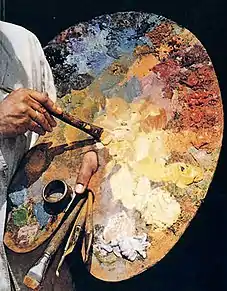Palette (painting)
A palette /ˈpælɪt/, in the original sense of the word, is a rigid, flat surface on which a painter arranges and mixes paints. A palette is usually made of wood, plastic, ceramic, or other hard, inert, nonporous material, and can vary greatly in size and shape. The most commonly known type of painter's palette is made of a thin wood board designed to be held in the artist's hand and rest on the artist's arm. Watercolor palettes are generally made of plastic or porcelain with rectangular or wheel format with built in wells and mixing areas for colors.

Wet palette
A wet palette is a sealable container with a layer of absorbent material (such as paper towel or sponge) that can be soaked with water and a semi-permeable membrane (such as parchment, greaseproof paper or baking paper (silicone paper)) over that. The paint sits on the membrane and is kept wet by osmosis. The main purpose of the wet palette is to keep acrylic paint, whose drying is irreversible, workable. Only paints that are water soluble, such as acrylics, work on wet palettes, as it is the movement of water through the palette paper that keeps the paint wet. Wet palettes are easily made with common household supplies and many painters choose to use homemade ones, however many companies make commercial wet palettes.
See also
| Wikimedia Commons has media related to Painting palettes. |